3.7. Elasmobranch biology
Elasmobranchii is a subclass of Chondrichthyes or cartilaginous fish, including the sharks (superorder Selachii) and the rays, skates, and sawfish (superorder Batoidea). Sharks are an ancient class of fish that first appeared about 400 million years ago and have remained virtually unchanged for the past 70 million years while being a dominant animal group. Since then, sharks have diversified into over 500 species. Their success is largely due to the original genetic traits they inherited from their more primitive ancestors. This gives sharks unique adaptations allowing them to occupy some varied ecological niches. Sharks are found in all seas and are common to depths of 2.000 metres.

Sharks and other cartilaginous fish (skates and rays) have skeletons made of cartilage and connective tissue. Cartilage is flexible and durable, yet is about half the normal density of bone. This reduces the skeleton’s weight, saving energy. Because sharks do not have rib cages, they can easily be crushed under their own weight on land. Jaws of sharks, like those of rays and skates, are not attached to the cranium. Sharks have numerous sets of replaceable teeth. Shark teeth are embedded in the gums rather than directly affixed to the jaw, and are constantly replaced throughout life. Multiple rows of replacement teeth grow in a groove on the inside of the jaw and steadily move forward in comparison to a conveyor belt; some sharks lose 30,000 or more teeth in their lifetime. Cartilaginous fish have tough skin covered with dermal teeth also called placoid scales (or dermal denticles), making it feel like sandpaper. In most species, all dermal denticles are oriented in one direction, making the skin feel very smooth if rubbed in one direction and very rough if rubbed in the other. Denticles provide two functions, protection and in most cases, streamlining.
All cartilaginous fish breathe through five to seven pairs of gills, depending on the species. Unlike other fish, shark gill slits are not covered, but lie in a row behind the head. In general, pelagic species must keep swimming to keep oxygenated water moving through their gills, whilst demersal species can actively pump water in through their spiracles and out through their gills. A spiracle is a small hole found behind each eye. Many larger, pelagic species, such as the mackerel sharks (Lamnidae) and the thresher sharks (Alopiidae), no longer possess them. Many fish maintain buoyancy with swim bladders. However elasmobranchs lack swim bladders, and maintain buoyancy instead with large livers that are full of oil. This stored oil may also function as a nutrient when food is scarce. Deep sea sharks are usually targeted for their oil, because the livers of these species can weigh up to 20% of their total weight.
Cartilaginous fish have several sensory organs which provide information to be processed. Ampullae of Lorenzini are a network of small jelly filled pores called electroreceptors which help the fish sense electric fields in water. This aids in finding prey, navigation, and sensing temperature. The lateral line system has modified epithelial cells located externally which sense motion, vibration, and pressure in the water around them. Most subspecies have the eyesight well adapted to the marine environment with the help of a tissue called tapetum lucidum. This tissue is behind the retina and reflects light back to it, thereby increasing visibility in the dark waters. Also, they have very powerful nostrils and olfactory organs.
Fertilization is internal. The posterior part of a male shark pelvic fins are modified into a pair of intromittent organs called claspers, analogous to a mammalian penis, of which one is used to deliver sperm into the female. Development is usually live birth after the eggs hatch in the oviduct within the mother’s body and the egg’s yolk and fluids secreted by glands in the walls of the oviduct nourishes the embryos (ovoviviparous species) but can be by laying the fertilized eggs in the water (oviparous). Some rare species are viviparous (the gestation of young that results in live birth). There is no parental care after birth; however, some cartilaginous fish do guard their eggs.
Most sharks are carnivorous. The great white and other large predators either swallow small prey whole or take huge bites out of large animals. Basking sharks, whale sharks, and megamouth sharks have independently evolved different strategies for filter feeding plankton: basking sharks practice ram feeding, whale sharks use suction to take in plankton and small fishes, and megamouth sharks make suction feeding more efficient by using the luminescent tissue inside of their mouths to attract prey in the deep ocean. This type of feeding requires gill rakers – long, slender filaments that form a very efficient sieve – analogous to the baleen plates of the great whales. The shark traps the plankton in these filaments and swallows from time to time in huge mouthfuls. Other highly specialized feeders include cookiecutter sharks, which feed on flesh sliced out of other larger fish and marine mammals.

Batoidea is a superorder of cartilaginous fish commonly known as rays. Rays are distinguished by their flattened bodies, enlarged pectoral fins that are fused to the head, and gill slits that are placed on their ventral surfaces. Most batoids have five ventral gill slits laying under the pectoral fins on the underside. Many species of batoid have developed their pectoral fins into broad flat wing-like appendages. The eyes and spiracles are located on the top of the head. Batoids have a ventrally located mouth and can considerably protrude their upper jaw away from the cranium to capture prey. Bottom-dwelling batoids breathe by taking water in through the spiracles, rather than through the mouth as most fishes do, and passing it outward through the gills. Most batoids have developed heavy, rounded teeth for crushing the shells of bottom-dwelling species such as snails, clams, oysters, crustaceans, and some fish, depending on the species. Manta rays feed on plankton. Most species live on the seafloor, mainly in coastal waters, although some live in deep waters to at least 3.000 m. Most batoids have a cosmopolitan distribution, preferring tropical and subtropical marine environments, although there are temperate and cold-water species. Only a few species, like manta rays, live in the open sea.

